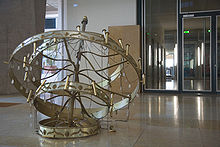Skyscraper to the palm tree
The high-rise zur Palme , completed in 1964, is one of the oldest high-rise buildings in the city of Zurich . It was built by the architects Max Ernst Haefeli , Werner Max Moser and Rudolf Steiger and is located at Bleicherweg 33 in the Enge district .
history
The name Hochhaus zur Palme comes from the previous building, a villa completed in 1837 by the architect Hans Conrad Stadler with a large and lush garden. The villa was sold to Caspar Baumann in 1862 by Conrad Escher vom Glas (1833-1919), one of his brothers and his two brothers-in-law . He transferred the name of his previous residence in Horgen to the newly acquired property, which was henceforth called zum Palme . Obviously, Conrad Escher's sisters were not trusted to handle a sale or their inheritance went directly to the husbands.
The impetus to demolish the villa and build a new commercial building came from Walter Baumann, a great-grandson of Caspar. He commissioned the Haefeli Moser Steiger office to draw up the plans and secured financial support from the then Schweizerische Kreditanstalt, now Credit Suisse . A large part of the building is still occupied by the bank today. In 1956 the plans were ready for construction, but it would take three years before excavation could begin. The preservation authorities fought against the demolition of the old villa, as a number of historical buildings were demolished at the time and the old palm tree was the second-last existing building by Hans Conrad Stadler in Zurich. Not least thanks to the high-rise section introduced in 1956, the building permit was finally granted. The inauguration took place on April 18, 1964.
The high-rise zur Palme with its windmill-like floor plan was a lot to talk about in Zurich at the time. It was all about the automobile, which is considered to be progressive : on the ground floor there has always been a gas station, a Silberkugel fast food bar and a branch of Credit Suisse (formerly Schweizerische Kreditanstalt). The roof of the base building can be used as a parking space via two self-supporting spiral ramps . This construction without supports was considered bold at the time. However, it had to be lightly supported afterwards because unpleasant vibrations occurred when driving on it. The cars on the roof are half-covered by filigree concrete elements. The concrete roofs are vaguely reminiscent of palm leaves, which fits the name of the house. On the first basement there is a parking garage with washing boxes. The washing boxes are under the forecourt to the entrance, where there is a fountain by Erwin Rehmann. This fountain has a transparent bottom and thus serves as a skylight for the washing boxes.
Haefeli, Moser and Steiger received international recognition for the building. Some recognize the font by Frank Lloyd Wright , for whom Moser temporarily worked. They were denied official recognition in Zurich itself. It can be assumed that the award for good buildings was refused in connection with the objection to the preservation of monuments.
The 50 m high building including the lift superstructures had to be extensively refurbished and renovated. Estimates of the size of the installed oil tanks (316'000 l on 15'500 m² rental space) indicate a very high energy consumption, so that measures to increase energy efficiency and to remove the asbestos that were common at the time are likely to have been necessary. This expenditure now considerably exceeds the construction costs of CHF 21 million at the time.
architectural art
Since 1996 there has been an installation by Ilya Kabakov called The Fallen Chandelier in the foyer . It is a golden chandelier that lies bent in the middle of the entrance on the floor. A broken cord hangs from the ceiling. The installation plays with the contrast between old and new, the chandelier could have come from the old villa, but it was specially made. It goes with the fact that the chandelier makes soft, glassy sounds. A relic of the old villa with its history weeps quietly to itself in the new environment. The reaction of passers-by “that mustn't be” and “how did the unsuitable chandelier get here” is the actual work of art.
literature
- Noémie Kubli: The "high-rise to the palm tree" . Diploma elective thesis ETH Zurich, 1997
- Peter Schindler u. Ilya Kabakov: From the house to the skyscraper to the palm tree . Kranich Zürich, 2003, ISBN 3-909194-14-1



